
Going hands-on with Digimon Story: Time Stranger left me feverishly wanting to play the full game immediately
The game that surprised me the most at this year’s Summer Game Fest was Digimon Story: Time Stranger. I was able to play a hands-on demo with the upcoming entry in the Digimon Story series, and interviewed Producer Ryosuke Hara immediately after it. Although I played the past Digimon Story games that were released in the west (Cyber Sleuth and Hacker’s Memory), I admit that I wasn’t their biggest fan. Their subpar English localization scripts did lead to some unintentionally comedic lines, but their gameplay systems felt a bit too basic and repetitive for me.
My brief time with Time Stranger reassured me that this was a massive step-up already. I started the demo at a fairly early part into the game in the Digital World, after a brief introduction of several details that were previously shared before. Unlike past entries, Time Stranger will support an English dub option; plus, there will be over 450 Digimon in the game which makes it the largest roster in a Digimon Story game so far.
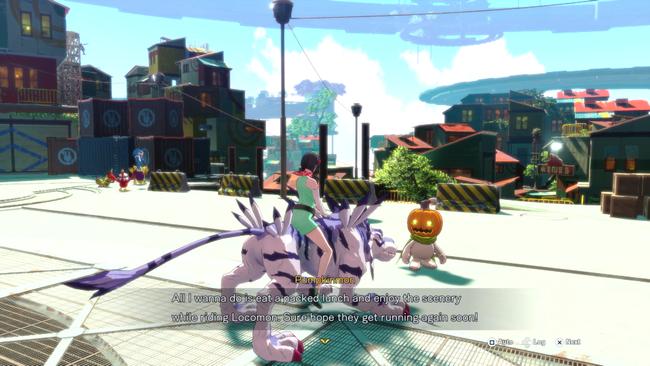
I started off the demo in Central Town, the home town hub in the Digital World for this title. It’s a lovely, lively place with various Digimon living out their daily lives. The developers have done an awesome job crafting how certain Digimon would operate in a societal framework, such as a Zudomon using its massive hammer on an anvil and a whole entire bar area filled to the brim with Digimon. Central Town also contains a few winks and nods to anime series fans; I caught an Andromon and Arukenimon speaking to each other from the corner of my eye.
One of the first things that I got to do was ride a Garurumon mount! The recent release date trailer teased this feature, and it seems like a plethora of Digimon will be available as mounts. Even the way the protagonist interacts with them is different on a case-by-case basis, such as holding onto Beelzemon’s back as Beelzemon rides its trusty Behemoth motorcycle or riding on top of Monzaemon’s shoulder. I am already a big fan of this feature.
We briefly traversed through Central Town and spoke with a Pegasusmon to take us to its outskirts. Before running over to several hostile Digimon to initiate battle, I was informed that L2 allows players to perform a scan of their surrounding area to see which environmental objects were interactable. Pressing R2 on a few nearby barrels fired off the main character’s blaster to destroy them; the Bandai Namco presenter told us that this could reveal hidden pathways in some cases.
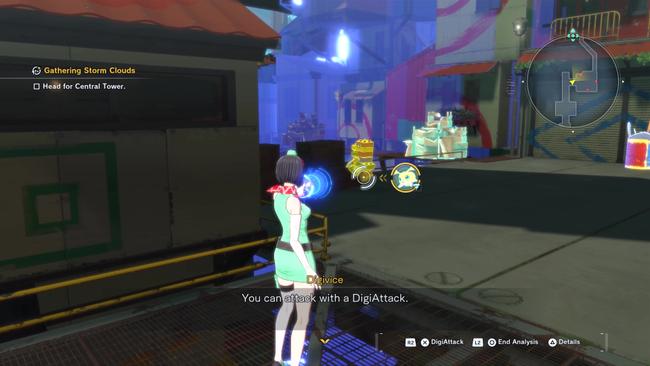
This R2 blaster button can also be used to initiate battles with hostile Digimons on the field and get a pre-emptive strike on them. If players outlevel the enemy group though, the blaster will just annihilate them on the spot and still receive EXP from them.
Of course, actual combat is still turn-based like in the previous Digimon Story games. Digimon’s rock-paper-scissors system with Data, Vaccine, and Virus-type Digimon is still present, along with different elemental types thrown into the mix. People won’t know what a Digimon is weak or resistant against until they do the tried and true method of trial and error.
Time Stranger allows for up to four active party members in battle. This consists of three of your own Digimon and a guest party member Digimon. Another three Digimon can be placed in reserve, and are freely swappable with any of the player’s Digimon without using up their turn; the guest Digimon will act on their own. For this demo, Minervamon was my guest party member.
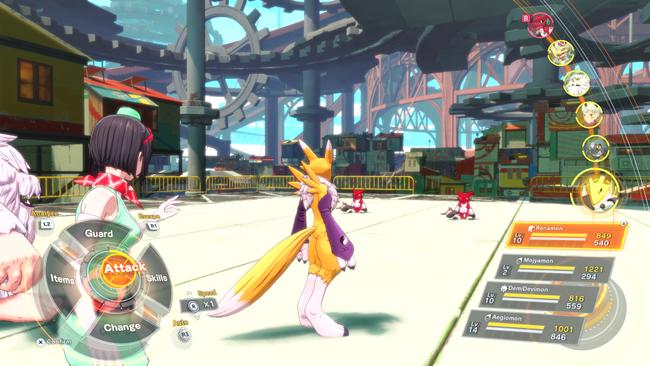
When I checked the party menu, my eyes immediately darted at the inventory cap of 999. Yes, that means you can carry up to 999 potential party members to put into your party at any given time. Even if the Digimon aren’t in your active or reserve slots, they’ll still continually earn EXP at a reduced rate.
In order to get new Digimon into your party, there is a Scan Rate percentage attached to Digimon that people encounter. If the Scan Rate is 100% for any given Digimon, players can recruit them into their party; for reference, defeating two of a Rookie-level Digimon put their Scan Rate to 40% but I’m not sure if this rate will be different for the other Digivolution Stages such as Champions, Ultimates, and so-on.
People can choose to go beyond 100% Scan Rate all the way to 200%, though. If they recruit a Digimon at 200% Scan Rate, their level cap will be increased and certain stats for that Digimon may be increased when they join you. This Scan Rate conversion system was present in Cyber Sleuth and Hacker’s Memory, but the way it manifests in Time Stranger seems more straightforward.
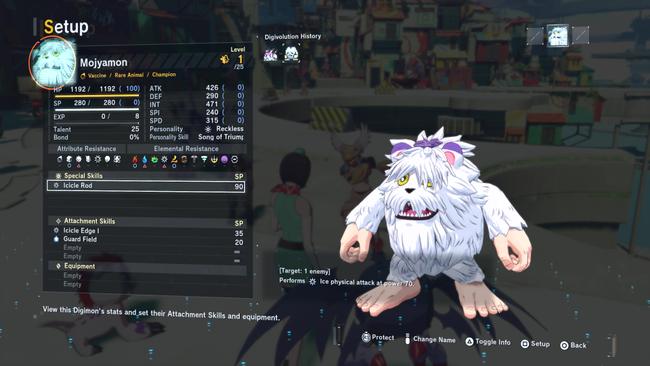
While the 3D cel-shaded models of the Digimon are slick, the Digimon party menu that lets players manage their Digimon uses unique 2D pixel sprites for each of them - much like how they would look inside old Digivices. The Terriermon I chose to Scan Rate convert looked adorable in this style. I was astounded when the Bandai Namco presenter told me that every single Digimon in Time Stranger would have a unique Digivice-esque sprite model for them. Give me this game now.
Each Digimon has Special Skills inherent to that specific Digimon, and Attachment Skills which are abilities that are purchasable in shops. There are equipment slots for Digimon too, so there’s a lot of flexibility in how people can tune their party setups.
I got the chance to see the Digivolution (and de-Digivolution) menus in Time Stranger. They are laid out in columns now, and navigating them seemed way more intuitive than how I remember in the previous Digimon Story entries. The Digimon franchise has non-linear evolutionary paths for its digital monsters, so a single Digimon can potentially evolve into 4-5 completely different ones. There was a column full of silhouettes for the Veemon I was about to Digivolve; through sheer luck, I happened to choose the silhouette that Digivolved it to Veedramon.
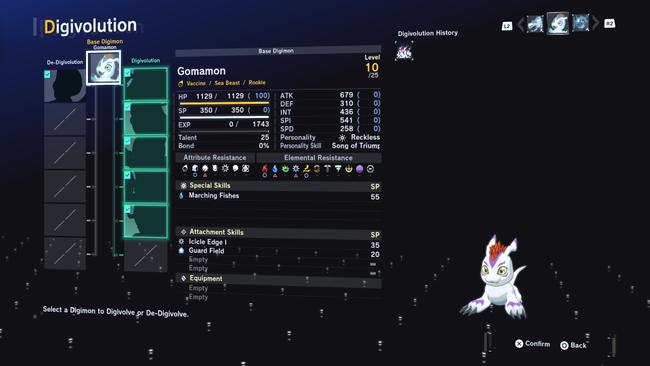
After learning the basics, I was taken to the final part of the demo - a boss battle against Parrotmon on top of a stormy electrical tower. Apparently, I was the first player in all of the Time Stranger appointments up to that point to use buffs in that boss fight. I started off the fight using attack up and critical rate up buffs, and I guess that impressed the Bandai Namco employees present there. I’m not sure what to make of this, since it’s one of the most basic strategies in RPGs.
Either way, this is how we unintentionally learned that using buffs only applies to active Digimon on the field; they are not applied to reserve party members. When I switched out my Digimon to a type that was strong against Parrotmon, they sadly did not have the buffs I previously used.
There were several other miscellaneous battle options I was clued in on. People can press L2 in a fight to analyze their foes to review what resistances and weaknesses they’ve previously uncovered against that type of enemy. Field hazards are a factor for some fights; several lightning bolts hit the field throughout my battle against Parrotmon, since we were all on top of an electrical tower.
Tilting the right stick up can increase the battle speed up to 5x. Other speeds would fast-forward battle animations, but the fastest speed would cut aspects of the animation to shorten them altogether. There is an auto-battle toggle that I could see, but I wasn’t able to test this out. A few skills would trigger an Extra Strike mechanic, which involved a fast timed QTE that would do bonus damage if pulled off successfully. Don’t worry, this only seemed to apply for only a small number of skills and not for the vast majority of them.
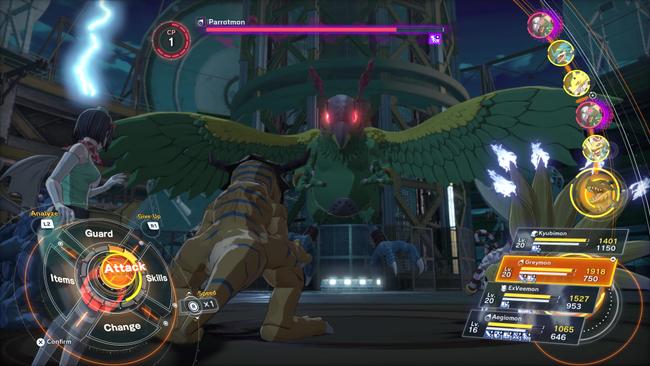
As I wrapped up the gameplay demo, the Parrotmon boss fight did undergo a few phase changes that switched up the design of the fight. I won’t go too much into specifics as to not spoil it, but there will be bosses that may switch up their elemental affinities as the fight progresses.
I left Digimon Story: Time Stranger wanting to play the full game immediately. As I played more of it, I thought about the dozens of hours I’ll probably sink into this game when it launches later this year. One of the weakest aspects of Cyber Sleuth and Hacker’s Memory was the samey looking dungeon environments, and Time Stranger is aiming to be a gigantic improvement in that regard. The Digital World: Iliad depicted in Time Stranger has already teased a variety of diverse biomes and locales throughout its trailers. Digimon Story: Time Stranger just might end up being one of my favorite games in 2025 at this rate.